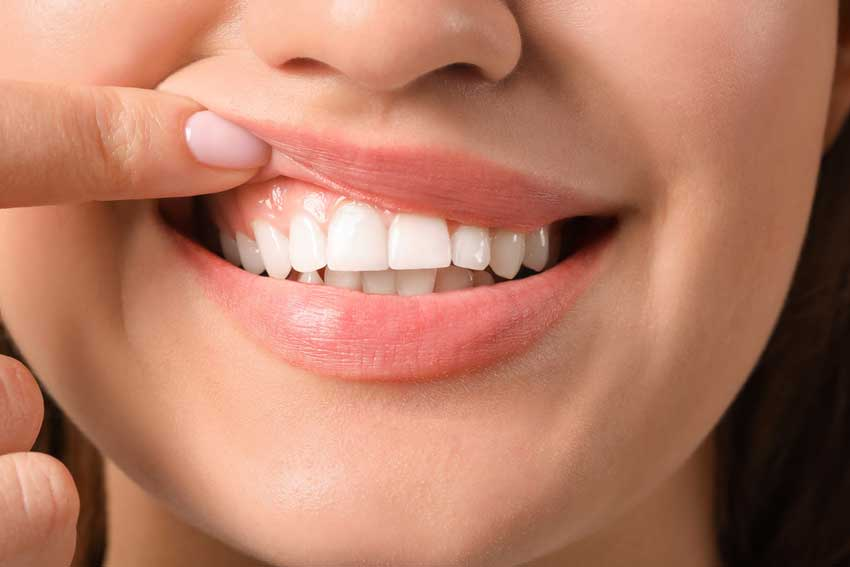Periodontium
Why care for your gums?
Submit your application right now, and get a discount on teeth whitening from our dentists. We will do everything efficiently and quickly!
- Prevention of gum disease ( periodontitis )
- Avoiding bad breath - Halitosis
- Protection of teeth from loosening and exfoliating
- Aesthetics - the harmony for white teeth and pink gums creates the aesthetic appearance.
- Other health benefits - There is growing evidence of gum disease associated with other health conditions such as heart disease, stroke, diabetes, respiratory conditions, pregnancy complications, Alzheimer's disease etc.

Periodontium
The periodontium is like a special group of body parts that help keep our teeth in place and protect them. It has different parts, like the gums (which we call the gingiva), the ligament that holds the tooth to the jawbone (called the periodontal ligament), a hard coating on the tooth root called cementum, and the bone that surrounds the tooth called the alveolar bone.
The gums are like a soft blanket around the teeth, and they help keep out germs and protect the tooth. The periodontal ligament is like a strong rope that holds the tooth in place and makes sure it doesn’t fall out. The cementum is like a hard shell that covers the tooth root and helps keep everything together. And the alveolar bone is like a strong wall that surrounds the tooth and keeps it stable.
Sometimes, we can get problems with the periodontium, like when our gums start to recede or move away from the teeth, or when we get deep spaces between the gums and the tooth called pockets. These problems can make our teeth feel sensitive or loose. So, it’s important to take care of our gums and the rest of the periodontium by brushing our teeth properly and visiting the dentist regularly.
Periodontitis
Periodontal disease, commonly known as gum disease, is a chronic inflammatory condition that affects the gums and supporting structures of the teeth. It is a prevalent oral health issue and one of the leading causes of tooth loss in adults.
Causes of Periodontal Disease
Periodontal disease is primarily caused by a bacterial infection. The mouth is home to hundreds of different types of bacteria, mostly harmless. However, certain bacteria, such as Porphyromonas gingivalis and Aggregatibacter actinomycetemcomitans, can become harmful when they accumulate and form a sticky, colorless plaque on the teeth. This plaque hardens over time to form tartar or calculus.
Plaque and tartar are significant contributors to the development of periodontal disease. They provide a breeding ground for more bacteria, leading to an excessive immune response by the body. This immune response causes inflammation of the gums, which is the initial stage of periodontal disease known as gingivitis.
Certain risk factors increase the likelihood of developing periodontal disease. These include poor oral hygiene, smoking, hormonal changes (such as during pregnancy), diabetes, genetic predisposition, and certain medications that reduce saliva flow or cause overgrowth of gum tissue.
Signs and symptoms
1. Gingival (Gum) Symptoms
Gingival symptoms are one of the initial signs of periodontal disease. These symptoms primarily affect the gums and can be easily observed by individuals themselves or by a dental professional during an examination. Some common gingival symptoms of periodontal disease include:
- Redness: Healthy gums appear pink and firm, while inflamed gums often exhibit a reddish hue.
- Swelling: Infected gums tend to become swollen and appear puffy.
- Bleeding: Gingival bleeding during brushing, flossing, or even eating can indicate the presence of periodontal disease. If your gums bleed regularly, it is essential to seek professional help.
- Tenderness: Periodontal disease can cause the gums to become tender and sensitive to touch or pressure. Discomfort or pain in the gum area may be experienced.
- Other health benefits - There is growing evidence of gum disease associated with other health conditions such as heart disease, stroke, diabetes, respiratory conditions, pregnancy complications, Alzheimer's disease etc.
2. Changes in Gum Appearance
Apart from experiencing gingival symptoms, individuals with periodontal disease may also notice noticeable changes in the appearance of their gums. Some common changes include:
- Receding Gums: Periodontal disease can cause the gums to slowly recede or pull away from the teeth, exposing more of the tooth roots.
- Gum Pocket Formation: When periodontal disease progresses, the formation of spaces or pockets between the gums and teeth can occur. As the disease worsens, these pockets may deepen, leading to more severe complications.
- Gum Color Changes: In some cases, the gums may take on a purplish or bluish tint due to poor blood circulation caused by periodontal disease.
3. Oral Discomfort and Functional Difficulties
Periodontal disease can cause various discomforting symptoms and hinder normal functions related to oral health. Some of these include:
- Halitosis (Bad Breath): Persistent bad breath is a common symptom of periodontal disease. It is caused by the accumulation of bacteria and food particles in the gum pockets, leading to the production of foul-smelling gases.
- Loose or Shifting Teeth: As periodontal disease advances, the supporting structures of the teeth become weakened, resulting in tooth mobility or shifting.
- Change in Bite: Severe periodontal disease can lead to malocclusion or a change in the way the upper and lower teeth fit together during biting or chewing.
Treatment of Periodontitis / Gum disease
Before commencing any treatment, a thorough examination and diagnosis are essential. During the initial examination, a dentist or periodontist will evaluate the patient’s oral health, assess the severity of gum disease, check for any underlying conditions, and determine the most suitable treatment plan.
Common diagnostic methods include:
- Clinical Examination: The dentist inspects the gums, measures pocket depths around the teeth using a periodontal probe, looks for signs of inflammation or infection, and identifies any loose or missing teeth.
- X-Rays: These imaging techniques help evaluate the bone structure and identify any hidden bone loss or complications that cannot be seen during the clinical examination.
- Periodontal Charting: The dentist records the measurements of the gum pockets around each tooth to determine the extent of gum disease and monitor progress throughout treatment.
Non-Surgical Treatment Options:
- REVO NAP – Revolutionised New Attachment Procedure: This is the most advanced method to treat gum disease, which uses multiple lasers to control gum disease and form healthy periodontium.
- Scaling and Root Planning: This procedure involves carefully removing plaque and calculus (tartar) from above and below the gum line. Scaling eliminates bacteria and toxins, while root planing smooths the tooth’s root surfaces to facilitate gum reattachment and prevent further plaque buildup.
- Antibiotics:
- Local Delivery: Antibiotics in the form of gels, chips, or microspheres are placed directly into the gum pockets to eliminate bacteria and control infection.
- Systemic: Oral antibiotics may be prescribed in more severe cases to tackle persistent bacterial infection.
4. Routine Dental Cleanings: Regular dental cleanings every three to six months help maintain gum health, remove plaque and tartar, and prevent the progression of gum disease.
Surgical Treatment Options
- Flap Surgery: In cases of advanced gum disease where pocket depths are significant, flap surgery may be recommended. The gums are gently lifted back to allow access for deep cleaning and removal of diseased tissue. Once cleaned, the gums are repositioned to reduce pocket depths and promote healing.
- Bone and Tissue Grafts: These procedures are performed when gum disease causes significant bone loss or gum recession, aiming to restore the damaged structures. Bone grafts involve adding synthetic or natural bone to stimulate regeneration but outcomes are highly unpredictable, while tissue grafts utilize gum tissue from another area to augment the affected site.
Maintenance and Follow-Up Care
- After undergoing gum disease treatment, regular maintenance and follow-up care are crucial to prevent recurrence and maintain oral health. This may involve:
- Oral Hygiene: Practicing thorough oral care, including brushing twice a day, flossing, and using an antibacterial mouthwash as recommended by the dentist.
- Systemic: Regular dental cleanings help remove plaque buildup and monitor the healing process.
- Lifestyle Modifications: Quitting smoking and adopting a healthy lifestyle can significantly contribute to improved gum health.
- Ongoing Monitoring: Periodic check-ups allow the dentist or periodontist to evaluate the treated areas, monitor gum health, and address any concerns promptly
2. Remember, timely diagnosis and appropriate treatment play a vital role in successfully managing gum disease and promoting long-term oral health.
Factors Influencing Long-Term Success
Several factors contribute to the long-term success of REVO NAP
1.Patient compliance and oral hygiene maintenance
For REVO NAP to yield favorable long-term outcomes, patients must actively participate in post-treatment care. This includes meticulous oral hygiene practices, such as regular brushing, flossing, and using an antimicrobial mouthwash. Patients should also attend scheduled follow-up appointments to monitor their healing progress and ensure any potential complications are addressed promptly.
2.Disease severity and patient’s overall health
The long-term success of REVO NAP may be influenced by the initial severity of the periodontal disease and the patient’s overall health. Advanced stages of gum disease might require additional treatment or maintenance procedures to achieve optimal results. Moreover, certain systemic conditions, such as diabetes or smoking, can impair the healing process and affect the overall success of REVO NAP.
3.Dentist’s expertise and technique
The proficiency and experience of the dentist performing the REVO NAP procedure play a significant role in the treatment’s long-term success. A skilled dentist will ensure thorough removal of diseased tissue, proper laser settings, and precise assessment of periodontal pocket depths. Accurate and meticulous execution of the REVO NAP technique can greatly enhance the chances of successful long-term outcomes.
Conclusion
In conclusion, REVO NAP has emerged as a revolutionary and highly effective treatment option for individuals suffering from periodontal disease. Throughout this book, we have explored the various aspects and benefits of REVO NAP, acknowledging its potential to reshape the traditional landscape of gum disease treatment.
One of the key advantages of REVO NAP is its minimally invasive nature. By utilizing laser technology, REVO NAP significantly reduces the need for incisions and sutures, resulting in reduced discomfort and faster healing times for patients. Additionally, LANAP has shown promising results in preserving healthy gum tissue and promoting natural reattachment of the gum to the tooth’s root surface, leading to improved periodontal health outcomes.
Furthermore, REVO NAP’s ability to selectively target and remove diseased tissue while sparing healthy tissue has proven to be a game-changer in periodontal treatment. Traditional methods often involved the removal of healthy tissue along with the diseased areas, whereas REVO NAP offers a more precise and conservative approach. This not only contributes to better aesthetic outcomes but also helps in maintaining the structural integrity of the jawbone and preventing the progression of gum disease.
REVO NAP’s therapeutic benefits extend beyond the physical aspects of periodontal disease treatment. Patients who undergo REVO NAP often experience improved oral health-related quality of life, including a reduction in pain and discomfort, enhanced chewing ability, and increased self-confidence. These positive changes have the potential to positively impact an individual’s overall well-being and contribute to an improved sense of overall health. As with any medical treatment, REVO NAP is not without limitations. It may not be suitable for all gum disease cases, and its long-term effectiveness still requires further research and evaluation. Additionally, the availability of REVO NAP P may vary depending on the location and accessibility to laser technology. Nonetheless, REVO NAP represents a significant step forward in the field of periodontal disease treatment and offers a promising alternative for individuals seeking a less invasive and more effective solution.
In conclusion, REVO NAP has undoubtedly redefined the approach to treating gum disease. Its minimally invasive nature, ability to preserve healthy tissue, and positive impact on patients’ quality of life have positioned it as a groundbreaking treatment option.

